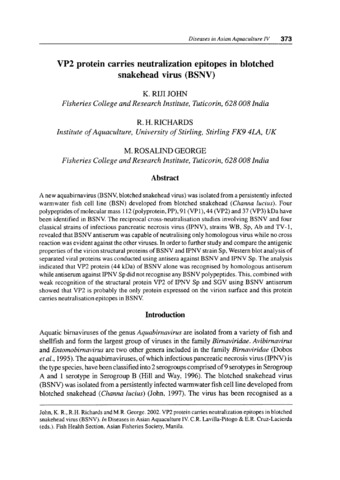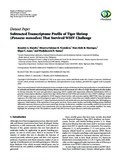VP2 protein carries neutralization epitopes in blotched snakehead virus (BSNV)
- Global styles
- MLA
- Vancouver
- Elsevier - Harvard
- APA
- Help
Share
Abstract
A new aquabirnavirus (BSNV, blotched snakehead virus) was isolated from a persistently infected warmwater fish cell line (BSN) developed from blotched snakehead (Channa lucius). Four polypeptides of molecular mass 112 (polyprotein, PP), 91 (VP1), 44 (VP2) and 37 (VP3) kDa have been identified in BSNV. The reciprocal cross-neutralisation studies involving BSNV and four classical strains of infectious pancreatic necrosis virus (IPNV), strains WB, Sp, Ab and TV-1, revealed that BSNV antiserum was capable of neutralising only homologous virus while no cross reaction was evident against the other viruses. In order to further study and compare the antigenic properties of the virion structural proteins of BSNV and IPNV strain Sp, Western blot analysis of separated viral proteins was conducted using antisera against BSNV and IPNV Sp. The analysis indicated that VP2 protein (44 kDa) of BSNV alone was recognised by homologous antiserum while antiserum against IPNV Sp did not recognise any BSNV polypeptides. This, combined with weak recognition of the structural protein VP2 of IPNV Sp and SGV using BSNV antiserum showed that VP2 is probably the only protein expressed on the virion surface and this protein carries neutralisation epitopes in BSNV.
Suggested Citation
John, K. R., Richards, R. H., & George, M. R. (2002). VP2 protein carries neutralization epitopes in blotched snakehead virus (BSNV). In C. R. Lavilla-Pitogo & E. R. Cruz-Lacierda (Eds.), Diseases in Asian aquaculture IV: Proceedings of the Fourth Symposium on Diseases in Asian Aquaculture, 22-26 November 1999, Cebu City, Philippines (pp. 373-380). Fish Health Section, Asian Fisheries Society.
Type
Conference paperISBN
9718020160Collections
Related items
Showing items related by title, author, creator and subject.
-
Evaluation of fish protein concentrate and lactic yeast as protein sources for shrimp feeds
Millamena, O.M.; Triño, A.V. (Asian Fisheries Society, 1994)Protein sources, hydrolyzed fish protein concentrate and plasmolyzed lactic yeast, were used to partially replace fish meal and soybean meal, respectively, in a basal diet (diet 1) at these levels; 5% fish protein concentrate ... -
Earthworm, marine annelids and squid as feed ingredients in formulated diets for juvenile Penaeus monodon
Pascual, F.P. (Aquaculture Department, Southeast Asian Fisheries Development Center, 1985)Earthworm and annelids were incorporated in diets for Penaeus monodon juveniles (mean weight 0.54 g) either in wet or dry form. These protein sources were added in amounts needed to replace 10% of the animal source of ... -
Subtracted transcriptome profile of tiger shrimp (Penaeus monodon) that survived WSSV challenge
Maralit, Benedict A.; Ventolero, Minerva Fatimae H.; Maningas, Mary Beth B.; Amar, Edgar C. ; Santos, Mudjekeewis D. (Hindawi Publishing Corporation, 2014)
There is increased interest in the development of virus-resistant or improved shrimp stock because production is currently hindered by outbreaks and limited understanding of shrimp defense. Recent advancement now allows ...
; Santos, Mudjekeewis D. (Hindawi Publishing Corporation, 2014)
There is increased interest in the development of virus-resistant or improved shrimp stock because production is currently hindered by outbreaks and limited understanding of shrimp defense. Recent advancement now allows ...






